Teenage Mutant Ninja Turtles
Action Figures
Series One Produced by Playmates in 1988

About The Toy Line
A Humble Beginning
Written By Wayne Scheiner
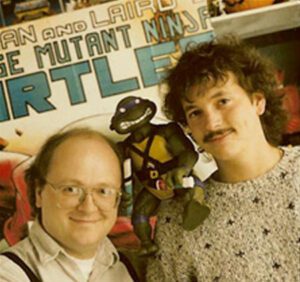 The Teenage Mutant Ninja Turtles started as a single independent comic book turned mass-media franchise and was created by Kevin Eastman and Peter Laird. The developed concept focuses on four anthropomorphic lead characters who become trained in the art of ninjutsu and fight crime and evil in the city streets. The mutated human-like turtles were discovered and instructed by their rat-like sensei and adoptive father, Splinter. He named them Leonardo, Michelangelo, Donatello, and Raphael, after his favorite historical art legends. The vigilante turtle team took on the city’s most powerful enemies through the years, including the evil Shredder and his antagonist faction, the Foot Clan. The four lead charters often collaborated with several human friends like street vigilante Casey Jones and news reporter April O’Neil, who always looked for trouble, and usually found it.
The Teenage Mutant Ninja Turtles started as a single independent comic book turned mass-media franchise and was created by Kevin Eastman and Peter Laird. The developed concept focuses on four anthropomorphic lead characters who become trained in the art of ninjutsu and fight crime and evil in the city streets. The mutated human-like turtles were discovered and instructed by their rat-like sensei and adoptive father, Splinter. He named them Leonardo, Michelangelo, Donatello, and Raphael, after his favorite historical art legends. The vigilante turtle team took on the city’s most powerful enemies through the years, including the evil Shredder and his antagonist faction, the Foot Clan. The four lead charters often collaborated with several human friends like street vigilante Casey Jones and news reporter April O’Neil, who always looked for trouble, and usually found it.
Creators Eastman and Laird developed the concept as a humorous parody, mocking traditional superhero personas by mixing popular elements of the time that generally do not relate to one another. Teenagers, sewers, mutating reptiles, urban vigilantes, superheroes, pizza, and the highly popular ninja craze of the early 80s. All these examples may have sounded quite fitting as standalone concepts on their own in the 1980s; however, they put them all together, and the rest is pop culture history. If you could overlook the absurd genius Eastman and Laird jokingly created in 1984 and found a way to open your mind to something new, you would soon be in for a groundbreaking multi-media treat, as they were.
 Kevin Eastman and Peter Laird first met in 1981 after being referred to each other by a local newspaper associate when Eastman was looking for work as an artist. The two quickly found that they shared similar artistic drawing styles and a love for comic books, especially the work of the great comic legend Jack Kirby. After a short time of collaborating remotely and a series of long weekend commutes from Main, Peter invited Kevin to move into his house in New Hampshire so they could expand their creative productivity. Along with Peter’s girlfriend, the three lived in the New Hampshire residence and took random jobs to make ends meet while they set up their art studio in the living room.
Kevin Eastman and Peter Laird first met in 1981 after being referred to each other by a local newspaper associate when Eastman was looking for work as an artist. The two quickly found that they shared similar artistic drawing styles and a love for comic books, especially the work of the great comic legend Jack Kirby. After a short time of collaborating remotely and a series of long weekend commutes from Main, Peter invited Kevin to move into his house in New Hampshire so they could expand their creative productivity. Along with Peter’s girlfriend, the three lived in the New Hampshire residence and took random jobs to make ends meet while they set up their art studio in the living room.
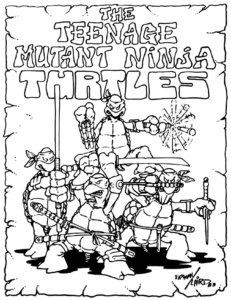 In 1983 Kevin Eastman showed Peter one of his recent concept sketches of an upright standing turtle in a Kung fu pose, wearing a ninja-style mask and holding nunchucks. Kevin thought his concept was hysterical; however, Peter liked the idea enough to attempt his own version of the character. Peter then shared his updated sketch of the ninja-like upright turtle with Kevin, who inspiredly took Peter’s updated sketch to the next level. Kevin added three more turtles, gave them unique weapons, then added the name “Ninja Turtles” to the top of the page. Equally inspired by each other, Peter took Kevin’s version and added “Teenage Mutant” to the title’s beginning, establishing the official birth of the now beloved franchise.
In 1983 Kevin Eastman showed Peter one of his recent concept sketches of an upright standing turtle in a Kung fu pose, wearing a ninja-style mask and holding nunchucks. Kevin thought his concept was hysterical; however, Peter liked the idea enough to attempt his own version of the character. Peter then shared his updated sketch of the ninja-like upright turtle with Kevin, who inspiredly took Peter’s updated sketch to the next level. Kevin added three more turtles, gave them unique weapons, then added the name “Ninja Turtles” to the top of the page. Equally inspired by each other, Peter took Kevin’s version and added “Teenage Mutant” to the title’s beginning, establishing the official birth of the now beloved franchise.
 The duo began sketching a series of sequenced comic-style pages, eventually leading to a completed professional-looking comic book. This first comic issue was black and white with only minimal color on the cover. It was titled “Teenage Mutant Ninja Turtles.” Interestingly, the original nemesis was killed off in the debut comic issue as the uncertainty of a follow-up issue was uncertain at the time.
The duo began sketching a series of sequenced comic-style pages, eventually leading to a completed professional-looking comic book. This first comic issue was black and white with only minimal color on the cover. It was titled “Teenage Mutant Ninja Turtles.” Interestingly, the original nemesis was killed off in the debut comic issue as the uncertainty of a follow-up issue was uncertain at the time.
Eastman and Laird created an official company called Mirage Studios and decided to fund and distribute the printed copies independently. The first print run of the “Teenage Mutant Ninja Turtles” comic issue was completed, printed, and delivered to the housemate’s living room sometime around May 1984.
The newly formed Mirage Studios printed approximately 3000 comic books of this first run, scraping together what little funds they had and obtaining a small loan from a family member of Kevin’s. Surprisingly, they quickly sold all 3000 copies in a few short weeks. Mirage Studios used the proceeds to purchase 6000 more copies of a second printing, which also had no problem selling out.
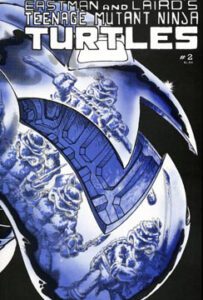 A few months later, issue number two was now ready for print. This time around, Mirage Studios printed 15,000 copies which saw a much more significant achievement in sales, confirming that the creative duo had something unique to offer to the comic book world. With the success of the first two independently released issues, Kevin and Peter were able to turn Mirage Studios into a full-time opportunity and ordered a third printing of issue number one, this time for 30,000 copies. Over the next three years, Mirage Studios added a small staff, including artists Steve Lavigne, Ryan Brown, Jim Lawson, and Michael Dooney to help speed up production. The team produced a total of 9 Teenage Mutant Ninja Turtles comic book issues and would set groundbreaking records for independently produced comic book sales.
A few months later, issue number two was now ready for print. This time around, Mirage Studios printed 15,000 copies which saw a much more significant achievement in sales, confirming that the creative duo had something unique to offer to the comic book world. With the success of the first two independently released issues, Kevin and Peter were able to turn Mirage Studios into a full-time opportunity and ordered a third printing of issue number one, this time for 30,000 copies. Over the next three years, Mirage Studios added a small staff, including artists Steve Lavigne, Ryan Brown, Jim Lawson, and Michael Dooney to help speed up production. The team produced a total of 9 Teenage Mutant Ninja Turtles comic book issues and would set groundbreaking records for independently produced comic book sales.
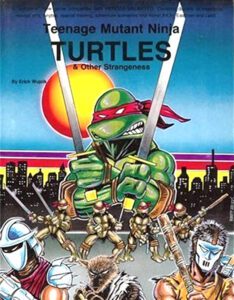 In the early days of Mirage Studios’ independent success, Eastman and Laird licensed the Turtle characters to a role-playing game as the very first licensed opportunity of the franchise. The game was titled “Teenage Mutant Ninja Turtles & Other Strangeness” and was published by Palladium Books in September 1985. The game’s primary rulebook featured original illustrations and comic strips from the Mirage Studios comic book series.
In the early days of Mirage Studios’ independent success, Eastman and Laird licensed the Turtle characters to a role-playing game as the very first licensed opportunity of the franchise. The game was titled “Teenage Mutant Ninja Turtles & Other Strangeness” and was published by Palladium Books in September 1985. The game’s primary rulebook featured original illustrations and comic strips from the Mirage Studios comic book series.
After turning down several mediocre licensing offers in fear of losing creative control, the two finally teamed up with entertainment agent Mark Freedman. Freedman would become instrumental in the franchise’s future and began shopping for the perfect licensing opportunity. Mirage’s new agent then shopped the concept to many of the major toy companies of the decade, including LJN, Mattel, and Hasbro, who all turned down the opportunity. After a few weeks of no success, Freedman contacted his friend Richard Sallis who had just started working for Playmates Toys. Playmates, over any other, seemed to show great interest in producing the line and thus began the negotiation process.
Playmates Toys, however, did have some concerns regarding adapting a few less edgy creative adjustments to the Turtles character format. Following the proven 1980’s commercial-driven roadmap to toy sale success, Playmates Toys felt that producing toys on the strength of comic sales alone may be less successful without an animated cartoon to help promote it. The toy manufacturer also felt this necessary to achieve the slightly younger target audience the toys would be promoted towards. Eastman and Laird ultimately understood Playmates’ directional concerns, and while still retaining complete creative control, a successful deal was eventually closed in 1986.
Playmates Toys Limited is an international toy company headquartered in Hong Kong. The company was founded as Playmates Industrial in 1966 by Sam Chan and started manufacturing dolls as a 3rd party supplier for other toy companies. Playmates finally began manufacturing and marketing its own pre-school-based toys in 1975 and opened an additional corporate location in Boston in 1977 and then California in 1983. It wasn’t until after the company became public in 1984 when Playmates finally experienced its first very successful toy with the 1986 release of the electronic cassette-playing robot doll “Cricket.”
 Playmates brought in a handful of artists and designers to take on the newly acquired Teenage Mutant Ninja Turtles licenses, including Manager of Product Design John Handy. Handy was tasked with essentially taking the edginess off the characters and increasing the fun and playability. Concept Development associates John Schulte and John Besmehn, along with Senior VP of Marketing Developing Karl Aaronian, were responsible for humorizing the tone and directing the image toward a more kid-friendly appeal. Adding to the dimensional feel of the final action figures, Playmates sculptors Steve Varner, Eddy Mosqueda, and a few others brought Eastman and Laird’s 2-dimensional comic book characters to life in the 3-dimensional world.
Playmates brought in a handful of artists and designers to take on the newly acquired Teenage Mutant Ninja Turtles licenses, including Manager of Product Design John Handy. Handy was tasked with essentially taking the edginess off the characters and increasing the fun and playability. Concept Development associates John Schulte and John Besmehn, along with Senior VP of Marketing Developing Karl Aaronian, were responsible for humorizing the tone and directing the image toward a more kid-friendly appeal. Adding to the dimensional feel of the final action figures, Playmates sculptors Steve Varner, Eddy Mosqueda, and a few others brought Eastman and Laird’s 2-dimensional comic book characters to life in the 3-dimensional world.
In February of 1987, Playmates felt somewhat discouraged after the dismal effect of shopping the concept to retailers pre-Toy Fare. Pitching concept sketches, unpainted prototypes, and less than five minutes of animated footage to retail giants like Toys-R-Us, Sears, and Kmart failed to express interest in the idea. With demonstrated lack of TMNT attention from retailers, Playmates corporate home offices in Hong Kong were not ready to commit to expensive tooling for the product line. Even though 1.5 million had already been invested in animated development and prototyping, the corporate headquarters considered cutting their losses and abandoning the project. Fortunately, that never happened.
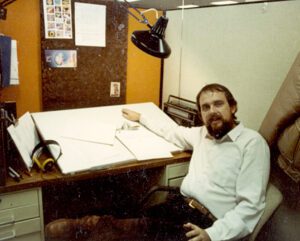 With development stagnant, Playmates recruited former Mattel toy designer Mark Taylor as the new Lead Designer for Playmates. Mark effectively replaced John Handy, who then, after departing Playmates, returned to working for Mattel. Mark Taylor’s status as a toy designer was legendary, crediting him with many of the iconic designs and characters of the highly successful Masters of the Universe line. Sprucing up some of the existing concepts and adding a few new characters from the original comic, Taylor added the finishing detail the line was missing.
With development stagnant, Playmates recruited former Mattel toy designer Mark Taylor as the new Lead Designer for Playmates. Mark effectively replaced John Handy, who then, after departing Playmates, returned to working for Mattel. Mark Taylor’s status as a toy designer was legendary, crediting him with many of the iconic designs and characters of the highly successful Masters of the Universe line. Sprucing up some of the existing concepts and adding a few new characters from the original comic, Taylor added the finishing detail the line was missing.
Around this time, veteran writer David Wise signed on to create content for the green-lit animated accompaniment. He quickly noted that the four lead turtle characters required individual personalities to help young viewers identify with individualize characteristics. To top off production, the now iconic TV producer Chuck Lorre worked as a composer and was commissioned to produce a theme song for the series. The future “Big Bang Theory” creator then wrote and produced the now iconic TMNT theme song that remains forever attached to the franchise in a catchy melodic form.
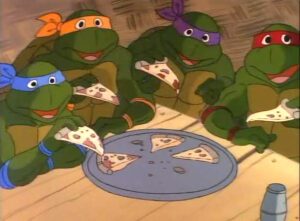 In December 1987, a five-part animated mini-series produced by MWS INC (Murakami-Wolf-Swenson) aired on syndicated stations. Thirteen official episodes followed in October the following year, accompanying the official launch of the action figure line.
In December 1987, a five-part animated mini-series produced by MWS INC (Murakami-Wolf-Swenson) aired on syndicated stations. Thirteen official episodes followed in October the following year, accompanying the official launch of the action figure line.
With over a year of hard work, Playmates finally introduced the then-unknown Teenage Mutant Ninja Turtles lineup at the 1988 New York Toy Fair in February. Despite a halfhearted reception from retailers, Playmates still moved forward with their investment, taking only a disappointing 3,000-piece order. By the time the upcoming 1988 holiday buying season opened, orders drastically increased, and the first wave, including ten action figures and five vehicles, were shipped to stores. Teenage Mutant Ninja Turtles became an instant success.
 In 1989, the Teenage Mutant Ninja Turtles action figures and vehicles far exceeded sales expectations paving the way for additional waves of new toys and eventually a live-action movie that would be released to theaters in 1990. Two additional live-action films would subsequently follow, seeing less popular success. However, the popularity of the animated series would continue to air with new episodes for a total of 10 seasons ending in 1996.
In 1989, the Teenage Mutant Ninja Turtles action figures and vehicles far exceeded sales expectations paving the way for additional waves of new toys and eventually a live-action movie that would be released to theaters in 1990. Two additional live-action films would subsequently follow, seeing less popular success. However, the popularity of the animated series would continue to air with new episodes for a total of 10 seasons ending in 1996.
In 2000 Kevin Eastman would sell his ownership of the Teenage Mutant Ninja Turtles franchise to his Mirage Studios partner Peter Laird in pursuit of other creative projects. In 2003, a darker animated version of the Teenage Mutant Ninja Turtle franchise was introduced and ran for six successful seasons. In 2007, a new 3D animated feature-length movie was released in theaters titled “TMNT.” Finishing off an amazing Mirage Studios run, in 2009, Peter Laird and Mirage Studios sold the franchise to CBS Viacom, which also owns Nickelodeon.
Nickelodeon would continue the TMNT franchise by releasing new successful Emmy-winning animated series accompanied by an all-new lineup of updated action figures. In 2014, a Live action / CGI Full-length movie with a $125 million budget hit theatres and grossed over a half $1 billion worldwide. A follow-up sequel, “Teenage Mutant Ninja Turtles Out of the Shadows,” was released in 2016 and only grossed 1/4 of the 2014 release; however, it was still considered a huge success.
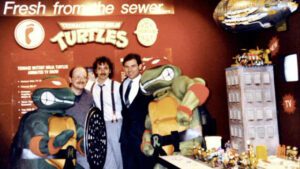 During its run, Playmates Toys sold approximately 1.1 billion USD of Teenage Mutant Ninja Turtles toys between 1988 and 1992, securing the toy line the third-bestselling action figures ever of its time. From its early beginnings as a humorous sketch to over three decades of successful films, multiple TV series, several lines of action figures, comic books, and an endless amount of merchandising, the Teenage Mutant Ninja Turtles may arguably be one of the best pop culture franchises of all time.
During its run, Playmates Toys sold approximately 1.1 billion USD of Teenage Mutant Ninja Turtles toys between 1988 and 1992, securing the toy line the third-bestselling action figures ever of its time. From its early beginnings as a humorous sketch to over three decades of successful films, multiple TV series, several lines of action figures, comic books, and an endless amount of merchandising, the Teenage Mutant Ninja Turtles may arguably be one of the best pop culture franchises of all time.
International Controversy
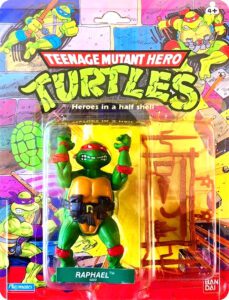 The British government strongly opposed violence in children’s television programming in the late 1980s and through most of the 1990s, and with the help of the BBFC (British Board of Film Classification), a crackdown on anything “ninja” or even “nunchucks” was considered inappropriate for children’s programming. When the Turtles franchise worked its way across the Atlantic Ocean to Europe, the enforced policy to protect young impressionable minds was far from exclusive to the UK and spread throughout many parts of Europe and even into Australia.
The British government strongly opposed violence in children’s television programming in the late 1980s and through most of the 1990s, and with the help of the BBFC (British Board of Film Classification), a crackdown on anything “ninja” or even “nunchucks” was considered inappropriate for children’s programming. When the Turtles franchise worked its way across the Atlantic Ocean to Europe, the enforced policy to protect young impressionable minds was far from exclusive to the UK and spread throughout many parts of Europe and even into Australia.
Many parts of the animated series were edited to cooperate with these international regulations, and the franchise was forced to rebrand slightly for select regions. Thus, the cartoon theme song lyrics, all action figure packaging, merchandising, and even video game box art needed to reflect the requested change. As a result, the “Teenage Mutant Ninja Turtles” was changed to “Teenage Mutant Hero Turtles” to appease the European and other overseas markets. The original 1987 five-episode mini-series was copped up, censored, and re-edited into one full-length feature video. The video cut was titled “Teenage Mutant Heroes Turtles How it All Began.”
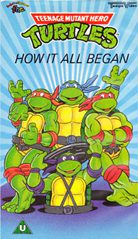 This censorship policy lasted throughout the original animated series and the complete run of the original Playmates toy line. Interestingly, this did not affect the 1990 live-action movie as the film did not air or cross paths with children’s programming in the UK. However, the regulation affected the 1997-1998 “Ninja Turtles The Next Mutation” TV series, renaming the show “Hero Turtles The Next Mutation.”
This censorship policy lasted throughout the original animated series and the complete run of the original Playmates toy line. Interestingly, this did not affect the 1990 live-action movie as the film did not air or cross paths with children’s programming in the UK. However, the regulation affected the 1997-1998 “Ninja Turtles The Next Mutation” TV series, renaming the show “Hero Turtles The Next Mutation.”
The censorship was finally lifted for the franchise as the updated 2003 animated version was not affected and was appropriately titled “Teenage Mutant Ninja Turtles.”
The 1988 Teenage Mutant Ninja Turtles TV Commercial
Above is a 1987 series one TV commercial for the launch of Playmates Teenage Mutant Ninja Turtles toy line. Most toy commercials from the 1980’s typically aired during after school programming and Saturday morning cartoons as they were common demographic timeslots for children’s programs. Often, the producers of the toy commercials creatively used scenes of children playing with the toys as part of their action-packed commercial-based marketing.

Collector's Price Guide
Click on the “Product Name” to view the collectibles detail page. You can refine your selection by selecting a year or series. You can also enter name into the search box, to find the collectible you are looking for in our data base. If using a mobile phone, click the “+” to view additional details and value data. All values are estimated by Retro Toy Quest and subject to change and discrepancy, depending on the advanced nature of any collector. Retro Toy Quest holds no responsibility for any possible inaccuracies displayed within this reference guide and values may often fluctuate in the current collectors market prior to or after published updates. PLEASE NOTE: Variants, Unpunched, Graded, Early Releases, International, and other unique variations may fetch a higher price point on the collectors market.
| Image | Product Name | Alliance | Type | Series | Year | MLC | MIB / MWC | MISB / MOC | More Information | Last Modified |
|---|---|---|---|---|---|---|---|---|---|---|
| https://retrotoyquest.com/wp-content/uploads/2022/05/Leonardo-THUMB.jpg | Leonardo | Good | Action Figure | 1 | 1988 | $45 | $55 | $300 | https://retrotoyquest.com/action-figure-leonardo-teenage-mutant-ninja-turtles-1988 | |
| https://retrotoyquest.com/wp-content/uploads/2022/05/Donatello-THUMB.jpg | Donatello | Good | Action Figure | 1 | 1988 | $45 | $55 | $300 | https://retrotoyquest.com/action-figure-donatello-teenage-mutant-ninja-turtles-1988 | |
| https://retrotoyquest.com/wp-content/uploads/2022/05/Raphael-THUMB.jpg | Raphael | Good | Action Figure | 1 | 1988 | $45 | $55 | $300 | https://retrotoyquest.com/action-figure-raphael-teenage-mutant-ninja-turtles-1988 | |
| https://retrotoyquest.com/wp-content/uploads/2022/05/Michaelangelo-THUMB.jpg | Michaelangelo | Good | Action Figure | 1 | 1988 | $50 | $60 | $310 | https://retrotoyquest.com/action-figure-michaelangelo-teenage-mutant-ninja-turtles-1988 | |
| https://retrotoyquest.com/wp-content/uploads/2022/07/April-ONeil-No-Stripe-THUMB.jpg | April O'Neil (No Stripe) | Good | Action Figure | 1 | 1988 | $65 | $75 | $180 | https://retrotoyquest.com/action-figure-april-oneil-teenage-mutant-ninja-turtles-1988 | |
| https://retrotoyquest.com/wp-content/uploads/2022/05/Shredder-THUMB.jpg | Shredder | Evil | Action Figure | 1 | 1988 | $45 | $55 | $200 | https://retrotoyquest.com/action-figure-shredder-teenage-mutant-ninja-turtles-1988 | |
| https://retrotoyquest.com/wp-content/uploads/2022/05/Foot-Soldier-THUMB.jpg | Foot Soldier | Evil | Action Figure | 1 | 1988 | $35 | $45 | $305 | https://retrotoyquest.com/action-figure-foot-soldier-teenage-mutant-ninja-turtles-1988 | |
| https://retrotoyquest.com/wp-content/uploads/2022/05/Bebop-THUMB.jpg | Bebop | Evil | Action Figure | 1 | 1988 | $35 | $45 | $265 | https://retrotoyquest.com/action-figure-bebop-teenage-mutant-ninja-turtles-1988 | |
| https://retrotoyquest.com/wp-content/uploads/2022/05/Rocksteady-THUMB.jpg | Rocksteady | Evil | Action Figure | 1 | 1988 | $40 | $50 | $250 | https://retrotoyquest.com/action-figure-rocksteady-teenage-mutant-ninja-turtles-1988 | |
| https://retrotoyquest.com/wp-content/uploads/2022/05/Splinter-THUMB.jpg | Splinter | Good | Action Figure | 1 | 1988 | $35 | $45 | $170 | https://retrotoyquest.com/action-figure-splinter-teenage-mutant-ninja-turtles-1988 | |
| https://retrotoyquest.com/wp-content/uploads/2022/05/TMNT-Cheapskate-THUMB.jpg | Cheapskate | Good | Action Vehicle | 1 | 1988 | $35 | $55 | $120 | https://retrotoyquest.com/action-vehicle-cheapskate-teenage-mutant-ninja-turtles-1988 | |
| https://retrotoyquest.com/wp-content/uploads/2022/05/TMNT-Knucklehead-THUMB.jpg | Knucklehead | Evil | Action Vehicle | 1 | 1988 | $45 | $90 | $165 | https://retrotoyquest.com/action-vehicle-knucklehead-teenage-mutant-ninja-turtles-1988 | |
| https://retrotoyquest.com/wp-content/uploads/2022/07/TMNT-1988-Turtle-Trooper-THUMB.jpg | Turtle Trooper | Good | Action Vehicle | 1 | 1988 | $35 | $50 | $130 | https://retrotoyquest.com/action-vehicle-turtle-trooper-teenage-mutant-ninja-turtles-1988 | |
| https://retrotoyquest.com/wp-content/uploads/2022/05/Turtle-Blimp-THUMB.jpg | Turtle Blimp | Good | Action Vehicle | 1 | 1988 | $155 | $230 | $550 | https://retrotoyquest.com/action-vehicle-turtle-blimp-teenage-mutant-ninja-turtles-1988 | |
| https://retrotoyquest.com/wp-content/uploads/2022/05/TMNT-Party-Wagon-THUMB.jpg | Turtle Party Wagon | Good | Action Vehicle | 1 | 1988 | $150 | $225 | $480 | https://retrotoyquest.com/action-vehicle-party-wagon-teenage-mutant-ninja-turtles-1988 | |
| https://retrotoyquest.com/wp-content/uploads/2022/02/Missing-Item-THUMB.jpg | The Whole Collection | NA | SERIES 1 TOTAL | 1 | 1988 | $860 | $1,190 | $4,025 | ||
| https://retrotoyquest.com/wp-content/uploads/2022/05/April-ONeil-THUMB.jpg | April O'Neil (Blue Stripe) | Good | Action Figure | 1 | 1988 | $40 | $50 | $80 | https://retrotoyquest.com/action-figure-april-oneil-teenage-mutant-ninja-turtles-1988 | |
| https://retrotoyquest.com/wp-content/uploads/2022/07/April-ONeil-Orange-Trim-THUMB.jpg | April O'Neil (Orange Trim) | Good | Action Figure | 1 | 1988 | $30 | $40 | $55 | https://retrotoyquest.com/action-figure-april-oneil-teenage-mutant-ninja-turtles-1988 |
How To Use This Price Guide
MLC = “Mint Loose Condition” This is when the action figure or Vehicle is in excellent condition, and is loose and “complete” with all original accessories, but without the packaging and original included paperwork.
MIB = “Mint in box” This is when the collectible is in excellent condition, and is loose and “complete” with all original accessories and original included paperwork.
MWC = “Mint with Card Back” This is when an action figure os is excellent condition, and is loose and “complete” with all original accessories, however included the original card back fully intact. If the original blister bubble is intact, It can bring additional value depending on the condition of the blister bubble.
MISB = “Mint in Sealed Box” This is when the Collectible is in excellent condition, and is factory sealed and was never opened or used.
MOC = “Mint on Card” This Is when the action figure is in excellent condition and is factory sealed and it’s original blister bubble and was never opened or used.
COMPLETE = “Complete” This is when the collectible is 100% complete with all of its accessories. Additional paperwork included with the original package does increase the overall value but does not necessarily consider the item complete
DISCLAIMER: Retro Toy Quest holds no responsibility for any possible inaccuracies displayed within this reference guide. Values may often fluctuate in the current collectors market prior to or after published updates. All values are estimated by Retro Toy Quest and subject to change and discrepancy, depending on the advanced nature of any collector. This collectors price guide is for informational and reference purposes only. Retro Toy Quest is not affiliated with any product or toy company referenced in this guide.
PLEASE NOTE: Variants, Unpunched, Graded, Early Releases, International, and other unique variations may fetch a higher price point on the collectors market. This reference guide is is designed for evaluating complete, in mint condition items only. Incomplete and lower quality conditioned items may fetch far lower price points, and need to be taken into consideration when evaluating your item.


